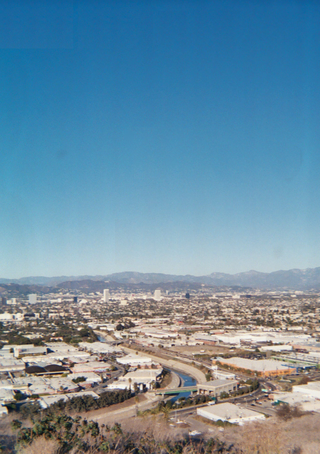Ballona Creek
| Ballona Creek | |
| stream | |
|
As seen from Baldwin Hills, the eastern end of Ballona creek near La Cienega Boulevard.
|
|
| Country | United States |
|---|---|
| State | California |
| Region | Los Angeles County |
| Tributaries | |
| - left | Centinela Creek |
| - right | Sepulveda Channel |
| Cities | Los Angeles, Culver City, Marina Del Rey |
| Source | |
| - location | Los Angeles, California |
| - elevation | 110 ft (34 m) |
| - coordinates | 34°02′39″N 118°21′12″W / 34.04417°N 118.35333°W |
| Mouth | |
| - location | Marina Del Rey, California |
| - elevation | 0 ft (0 m) |
| - coordinates | 33°57′37″N 118°27′33″W / 33.96028°N 118.45917°WCoordinates: 33°57′37″N 118°27′33″W / 33.96028°N 118.45917°W |
Ballona Creek is an 8.8-mile-long (14.2 km) waterway in southwestern Los Angeles County, California, whose watershed drains the Los Angeles basin, from the Santa Monica Mountains on the north, the Harbor Freeway (I-110) on the east, and the Baldwin Hills on the south. It heads in the historical Rancho Las Cienegas and flows through Culver City and the Del Rey district before emptying into Santa Monica Bay between Marina del Rey and the Playa del Rey district.
During the Pre-Columbian era, Tongva people existed as hunters and gatherers in small villages throughout the Ballona Creek watershed and other parts of the Los Angeles basin. Native American culture and land management practice was disrupted by the arrival of Spanish explorers.
In 1769, the Tongva met their first Europeans when Portola expedition came through on its way north. Continuing west after crossing the Los Angeles River, diarist Fray Juan Crespi noted that the party "came across a grove of very large alders...from which flows a stream of water...The water flowed afterwards in a deep channel towards the southwest". Researchers identified the place as the headwaters of Ballona Creek. The explorers made camp nearby on August 3.
Around 1820, a mestizo rancher named Augustine Machado began grazing his cattle on the Ballona wetlands and claimed a fourteen-thousand acre Mexican land grant that stretched from modern-day Culver City to Pico Boulevard in Santa Monica, California. Ballona Creek and Lagoon are named for the Ballona or Paseo de las Carretas land grant, dated November 27, 1839. The Machado and Talamantes families, co-grantees of the rancho, heralded from Baiona in northern Spain. After the land grant claims were lost, the area then experienced rapid growth, with open land being transformed into agricultural use.
...
Wikipedia

